Похожие презентации:
Malaria “Bad Air”
1.
Malaria“Bad Air”
2.
Malaria: Lecture Goals• Understand basic principles of malaria
pathogenesis in the context of relevance to
clinical disease and epidemiology
Understand the clinical symptoms of malaria
Understand the difference between
uncomplicated and severe malaria
Understand how to choose an antimalarial
Understand where to find up-to-date
resources for malaria
2
3.
Outline• Background
Organism
Epidemiology
Pathophysiology
• Clinical
Symptoms
Differential diagnosis
• Malaria in a complex emergency
Who is at risk
How to choose a medication
3
4.
Malaria• Caused by a
protozoal blood
parasite
Plasmodium vivax
Plasmodium ovale
Plasmodium
malaria
• Plasmodium falciparum
• Plasmodium knowlesi
*Often cause severe malaria
5.
• Transmission: Anopheles mosquito• Wide spectrum symptoms
Fever
1927 Nobel Prize: pyrotherapy for syphilis
• Geographical distribution:
Tropic / Subtropics
• 350-500 million infections worldwide/year
• 1-2 million deaths worldwide/year
6.
67.
•Liver stage:Asimptomatic. With P. vivax
and P. ovale, has dormant
form (hypnozoite) that can
relapse much later. This
form is not killed by most
malaria medications.
•Blood stage: Symptomatic.
Notice the continuous circle.
This will continue until
medication or immune
system eradicates (1-5+
years untreated). Once cycle
3-4 days, except P.
falciparum.
7
8.
Malaria: Endemicity andResistance
POWELL B , FORD C Cleveland Clinic Journal of Medicine 2010;77:246-254
8
9.
% Malaria P. falciparumhttp://www.who.int/gho/map_gallery/en/
9
10.
• ChloroquineChloroquine
Resistance
P. falciparum
areas
resistance and P.
falciparum overlap,
with exceptions:
Central America West
of Panama Canal
Haiti/Dominican
Republic
Middle East
Make easy: Rx P.
falciparum with ACT
• Mixed infection
possible
P. vivax
areas
Asia 20-30%
Africa usually P.
falciparum
Americas usually
P. vivax
10
11.
P. falciparum: Dangerous• Infects various RBC stages
• Makes RBCs “sticky”
• Result:
Severe hemolysis
Obstruction of microcirculation
Obstruction of capillaries
• Holo/hyperendemic
• Good News? Does not have hypnozoite
Hypnozoite: dormant liver form that causes relapse
with P. ovale, P. vivax
11
12.
Malaria in a ComplexEmergency: Symptoms
• SEVERE
• > 5% parasitemia
• Severe anemia
• Hemoglobinuria
• Bleeding diathesis
• Shock/Hypotension
• Renal failure
• Hypoglycemia
• Acidosis
• Neurologic abnormalities
Biggest killer
• UNCOMPLICATED
• Fever
Not always cyclic!
Chills, sweats
Headache
Myalgia
Diarrhea, nausea,
emesis
• Anemia (pallor of
palms)
• Thrombocytopenia
• Hepatosplenomegaly
13.
Malaria in a ComplexEmergency: Who is at Risk for
severe disease?
• Highest risk populations:
Non-immune
Immunocompromised, malnourished
Infants, young children, pregnant
Infected with P. falciparum
• In endemic areas, older children and
adults develop partial immunity
Can have “asymptomatic” infection
Can have subacute or chronic symptoms
14.
Malaria in a ComplexEmergency
• Displaced people within malaria endemic
areas creates risk for a severe epidemic,
particularly if the displaced persons are
from less endemic areas (highlands to
lowlands)
Laboratory diagnosis may be impractical
May become necessary to:
Treat some people based on clinical
history
Do mass fever treatment
14
15.
Malaria: Practical Aspects ofDiagnosis
• Presumptive treatment has been
commonplace for decades
Problematic, but hard to change
• Even in holoendemic countries, WHO
estimates <1/3rd of febrile episodes due
to malaria
In Africa, <20% of suspected cases
receive a confirmatory diagnostic test
15
16.
Malaria in a ComplexEmergency
• Important, when possible, to at least
establish a fever epidemic is due to
malaria
Do some diagnostics
• Combination of smears and rapid diagnostic
tests
• To establish malaria as cause
• To monitor epidemic curve
Evaluate for other diseases
Monitor clinical response
16
17.
Malaria: Differential Diagnosis• Malaria can involve many organs
• Coinfection well described
• Differential diagnosis is broad
Salmonella typhi and non-typhi
Staphylococcus aureus with focus (bone, joint, muscle, lung, heart)
Dengue, yellow fever, japanese encephalitis
Pneumonia
Viral and bacterial meningitis/encephalitis
Leshmaniasis
Schistosomiasis
Tuberculosis
Liver abscess/cholangitis
17
Oncologic process
18.
Malaria: Diagnostics• Rapid
diagnostic test (RDT)
Lateral flow test, relies on antibody-antigen interactions
Some RDTs specific for P. falciparum
WHO quality assurance programs underway
• Clinician/Public acceptance large problem
USA: only to confirm species
• Microscopy
Thick: diagnosis
Thin
• Identification and parasitemia
• % parasitized RBCs
18
19.
Clues to P.falciparum:
• Trophozoites most
commonly seen,
and are small,
delicate rings,
often multiple per
RBC; infect all
ages of RBC.
Gametocytes
“banana” shaped.
19
20.
Malaria: Treatment20
21.
CDCAlgorithm
for Traveler
Returned to
US
*Not the same as WHO
Note: CDC now recommending
treating severe malaria with
artesunate; treat with atovoquoneproquanil until it arrives (5-12 hours).
To enroll a patient with severe malaria
in this treatment protocol, contact the
CDC Malaria Hotline: 770-488-7788
(M-F, 8am-4:30pm, eastern time) or
after hours, call 770-488-7100 and
request to speak with a CDC Malaria
Branch clinician.
http://www.cdc.gov/malaria/diagnosis_
21
treatment/treatment.html
22.
Malaria: TreatmentWHO guidelines and
update can be found
at:
http://www.who.int/m
alaria/publications/at
oz/9789241549127/
en/
22
23.
Default ACTin the
Interagency
Emergency
Health Kit
Malaria: Therapy Options
• ACT (Artemisinin based combination therapies)
Artemethur + lemefantrine (coartem®)
Artesunate + amodiaquine (coarsucam/ASAQ Winthrop®)
Artesunate + mefloquine (AS+MQ)
Artesunate + sulfadoxine-pyrimethamine (AS+SP)
• Not for P. vivax
Artesunate + doxycycline or clindamycin
Dihydroartemisinin plus piperaquine (DHA+PPQ)
Quinine + doxycyline or clindamycin
Atovaquone + proguanil (malarone®)
Mefloquine (larium®)
Chloroquine (widespread resistance)
Primaquine (kills liver phase for P. vivax/ovale)
IV and IM: Artesunate, artemethur, quinine
Rectal: Artesunate
23
24.
Suspectedmalaria
-
Blood films or RDT if
available
Not
available
Repeat each
12-24 hours
for three sets
Decision
not to
treat
Reassess
each 12-24
hours,
evaluate
alternative
causes
+
Calculate
parasitemia
Evaluate probability
based on local
epidemiology
Decision
to treat
Categorize as
uncomplicated
or severe
24
25.
Uncomplicated malaria: treatmentP. falciparum possible by epidemiology or smear?
Use local resistance
patterns to choose
medication:
•Chloroquine
•ACT
•Hydroxychloroquine
•Atovoquone-proguanil
•Mefloquine
•Quinine + doxycycline
•* Re-dose if emesis within
30 min
If P. vivax/ovale and
patient not G6PD
deficient, treat with
primaquine
+
Use local resistance
patterns to choose
medication:
•ACT
•artesunate plus tetracycline
/doxycycline/clindamycin
•Quinine plus tetracycline
/doxycycline/clindamycin
•Atovoquone-proguanil
•Mefloquine
•Quinine + doxycycline
•* Re-dose if emesis within 30 min
Consider admission to
monitor disease
progression
25
26.
Severe Malaria: WHO CriteriaOne or more of the following:
• Clinical features:
• Impaired consciousness,
prostration
Failure to feed
Seizures
Respiratory distress
Circulatory collapse
Clinical jaundice plus
evidence of other vital organ
dysfunction
Gross hemoglobinuria
Abnormal spontaneous
bleeding
Pulmonary edema
(radiological)
• Laboratory findings:
• Hypoglycemia (blood glucose <
2.2 mmol/l or < 40 mg/dl)
Metabolic acidosis (plasma
bicarbonate < 15 mmol/l)
Severe normocytic anaemia (Hb <
5 g/dl, packed cell volume < 15%)
Hemoglobinuria
Hyperparasitaemia (> 2%/100
000/μl in low intensity
transmission areas or > 5% or
250 000/μl in areas of high stable
malaria transmission intensity)
Hyperlactatemia (lactate > 5
mmol/l)
Renal impairment (serum
creatinine > 265 μmol/l).
26
27.
Severe malaria: Treatment the same regardless of species!Therapy + supportive care:
Intravenous medications available?
no
Give oral or rectal
until patient can be
transferred to referral
center:
rectal artesunate
quinine IM • artesunate
IM
artemether IM
If illness is with P.
ovale/vivax, follow with
primaquine if not G6PD
deficient
yes
Ongoing supportive
care, including:
•evaluation for blood
transfusion
•treatment for
coinfection
•treatment of seizures
Treat IV x 24
hours minimum
Artesunate IV or IM
Artemethur Quinine
Follow with full course of oral antimalarial:
• ACT
• artesunate plus clindamycin or doxycycline
•quinine plus clindamycin or doxycycline
28
28.
Malaria: Prevention• Bed Nets!!!!!!
1000 nets save 5 lives
• Insecticide impregnated best
Cochrane Review, 2009
• Indoor/personal insecticides
• Vaccine: on the horizon?
Some candidates reaching clinical trials,
with short-lived efficacy
28
29.
Take Home Points• Malaria endemicity and seasonality depends on mosquito
habits, seasonality, and Plasmodium spp.
• Resistance to medications is species and location dependant
If P. faliciparum, assume chloroquine resistant
• Exception: Island of Hispaniola
• Clinical:
Who is at highest risk
How to differentiate severe vs. uncomplicated malaria
Differential diagnosis
• How to choose an anti-malarial treatment:
ACTs are preferred therapies, all species
• ACT if oral, artesunate if IV
Severe malaria treated same regardless of species
• Where to find up-to-date resources on Malaria
29
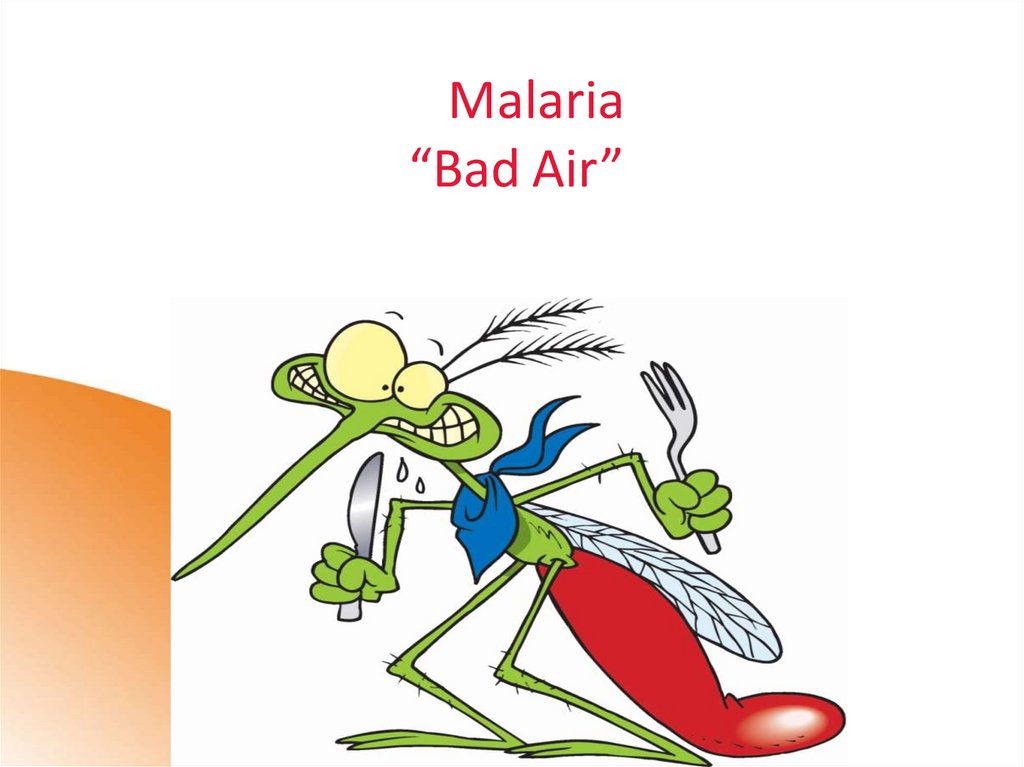













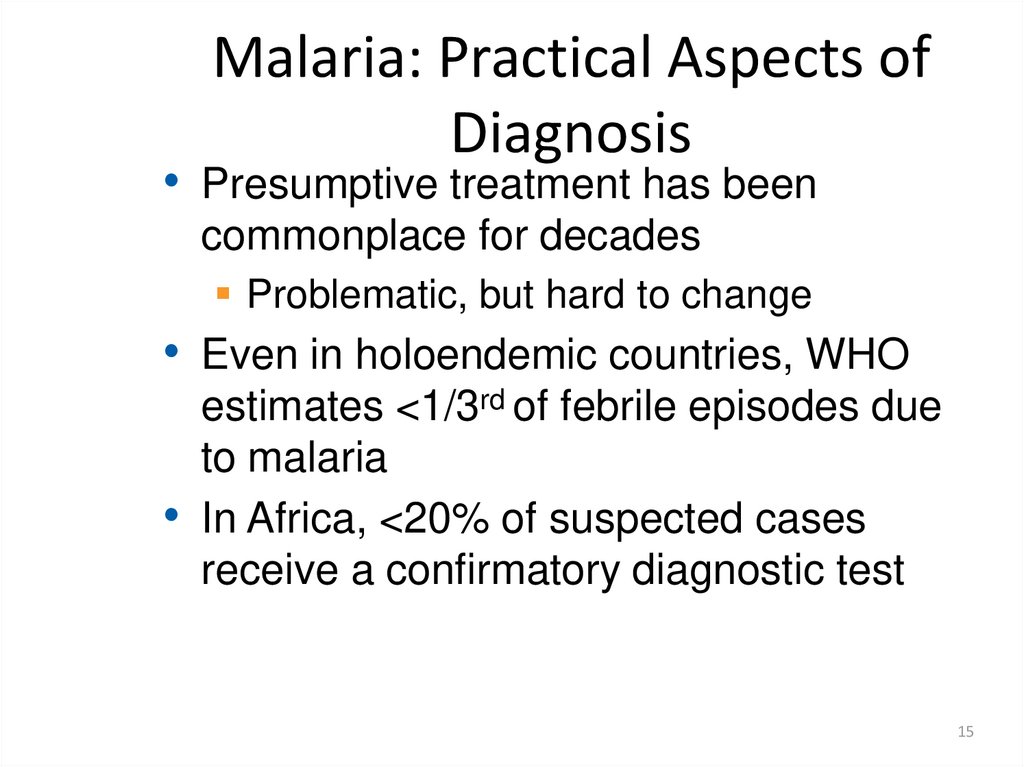
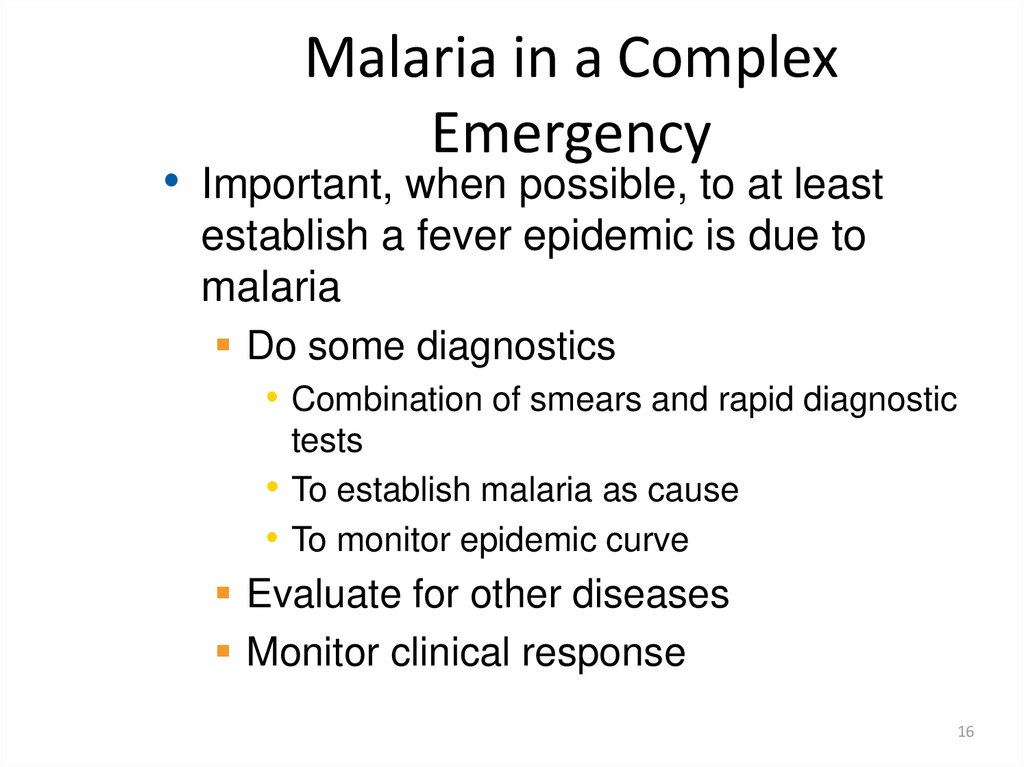


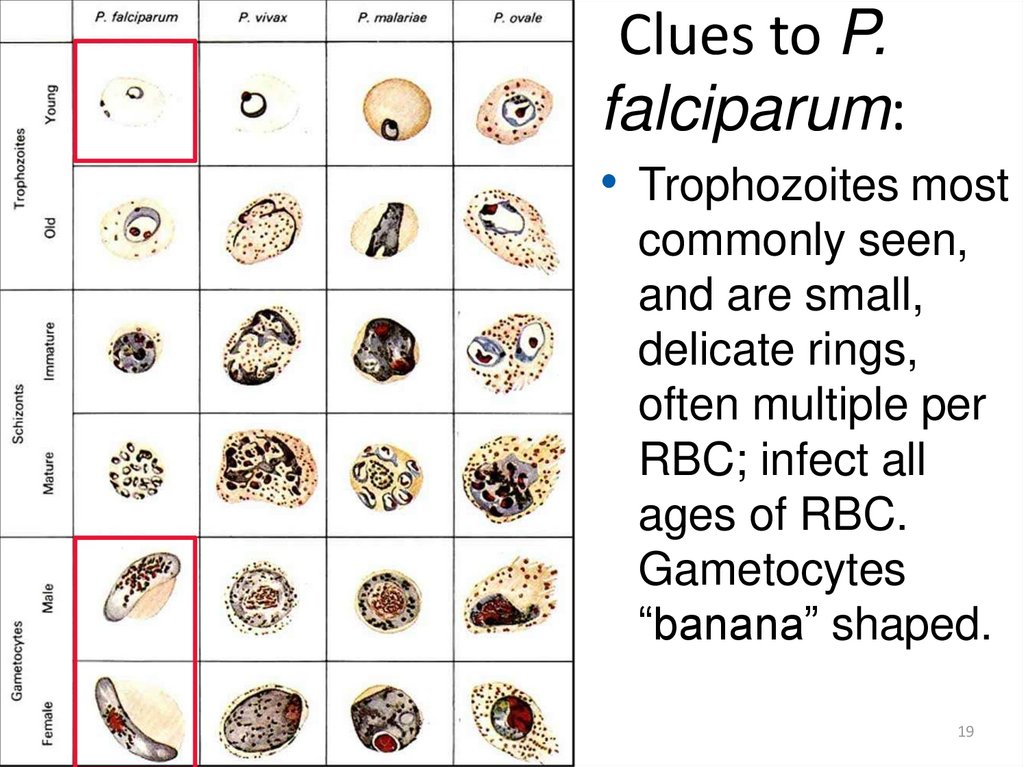
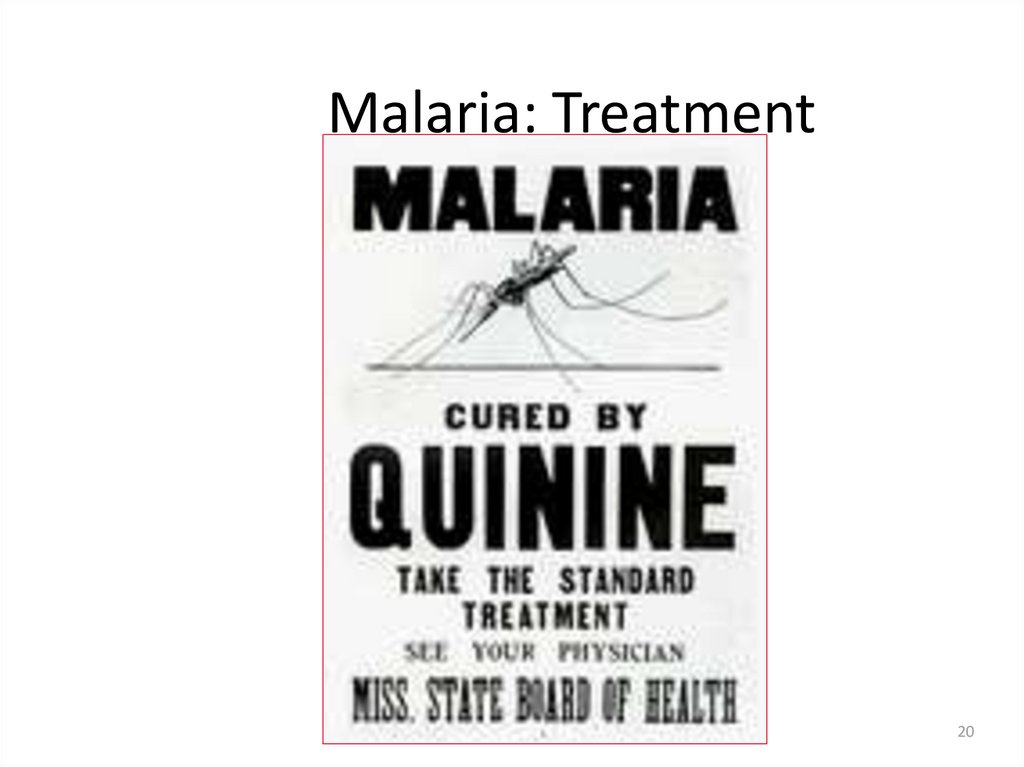
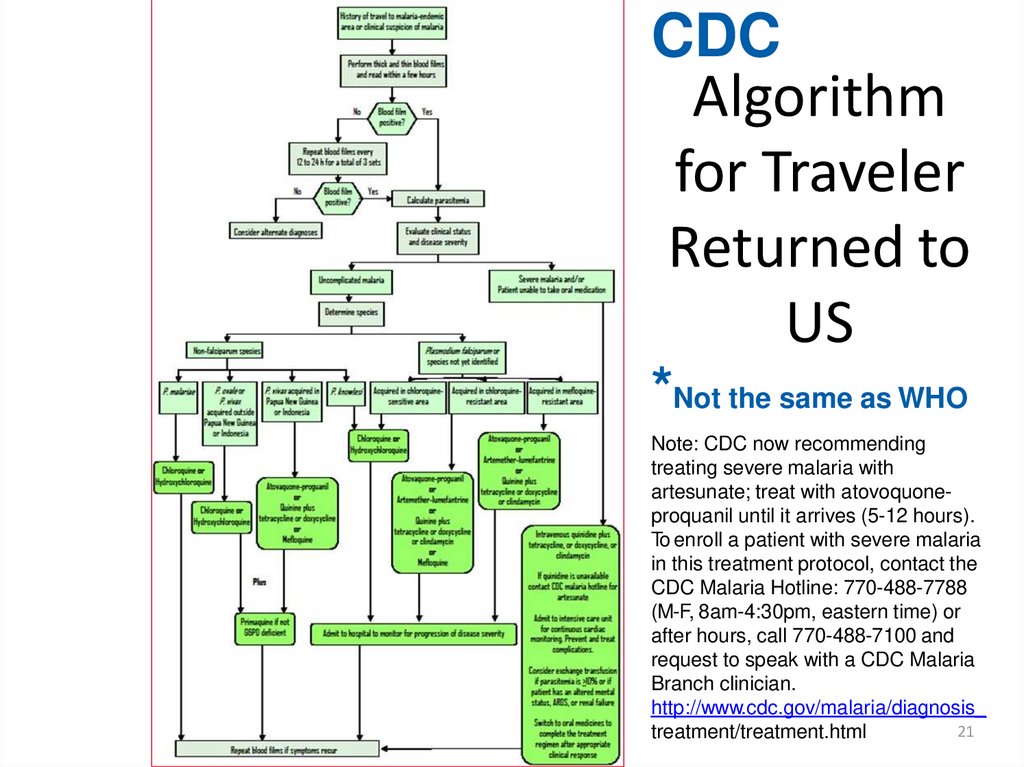
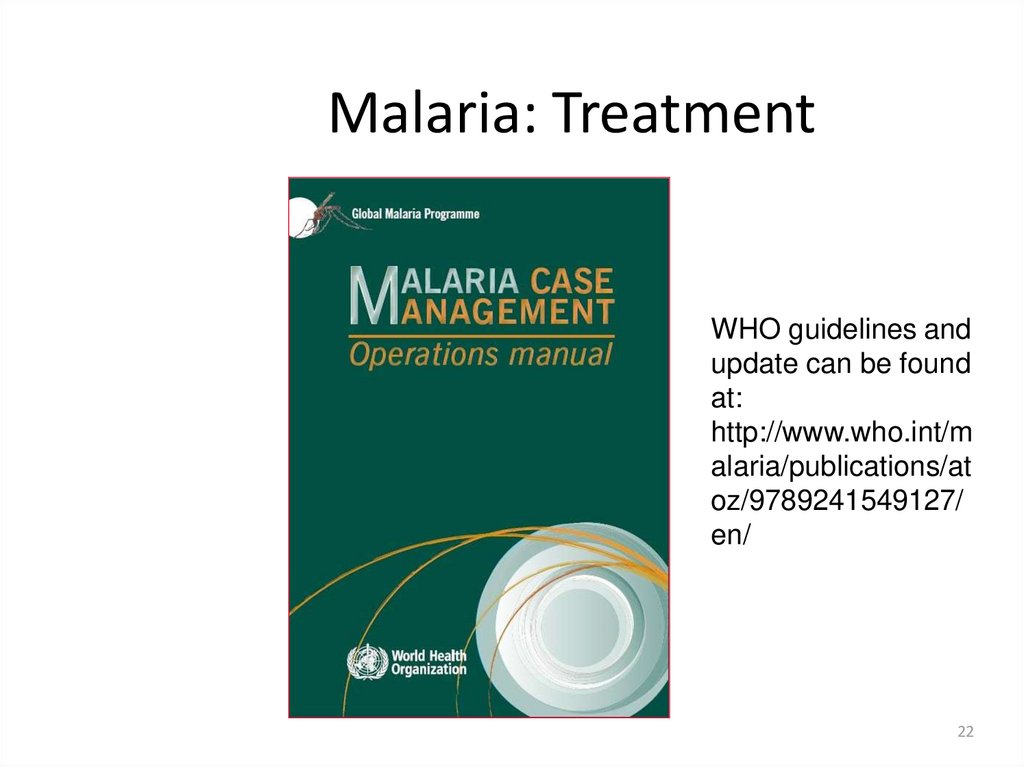
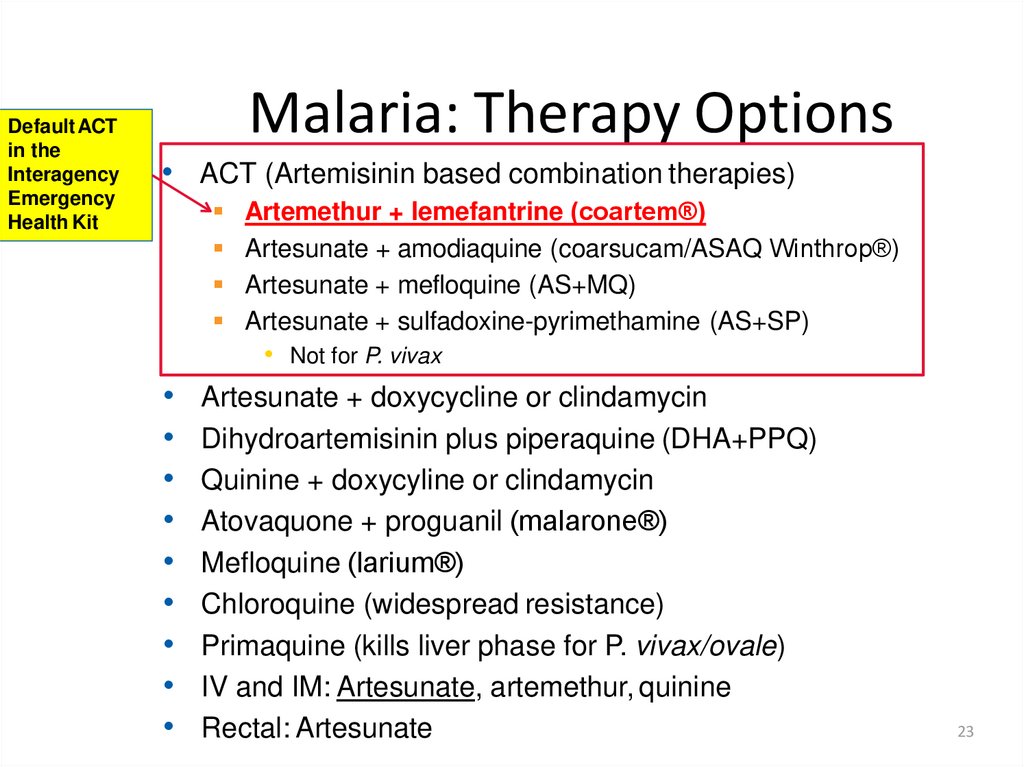
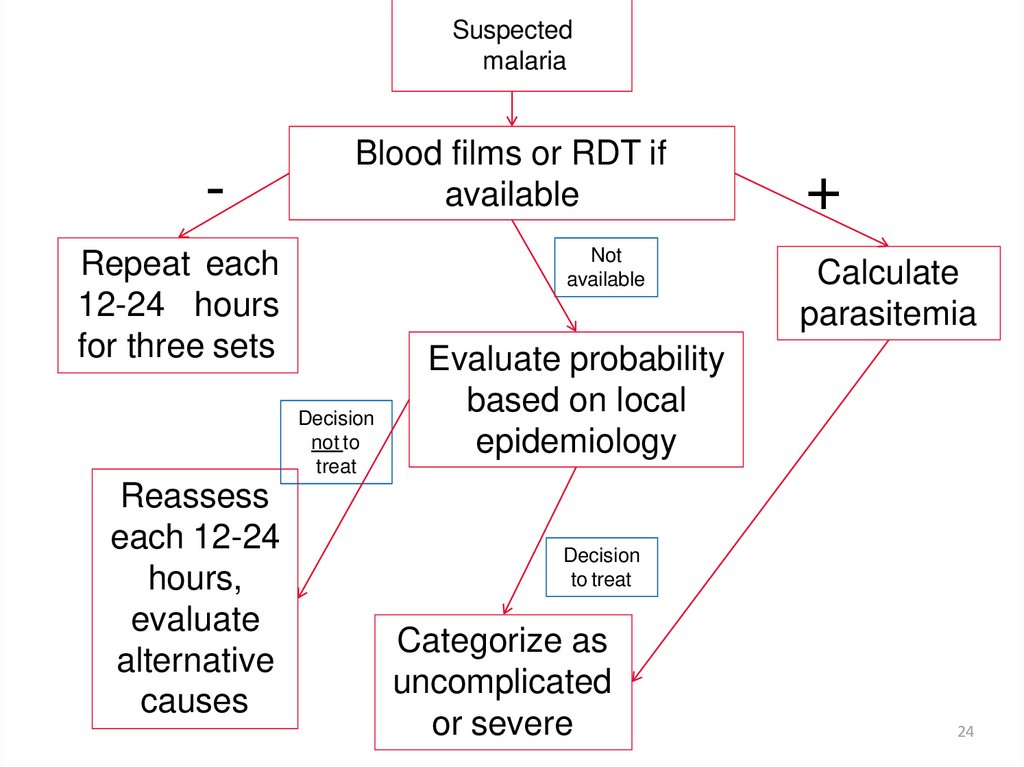
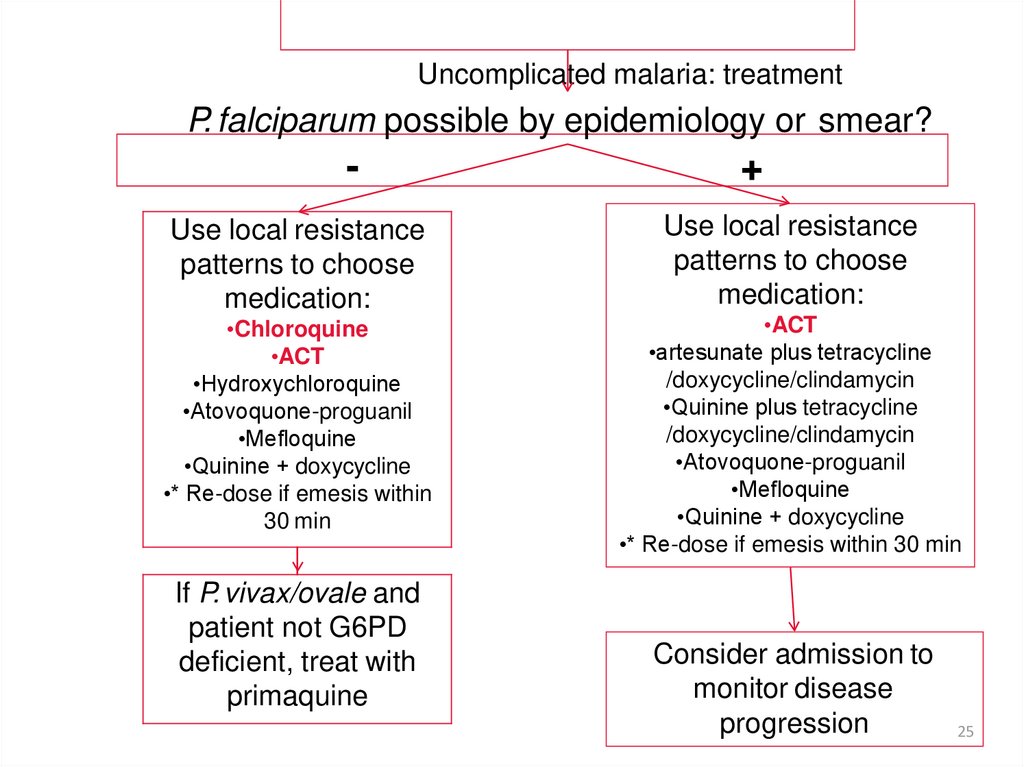
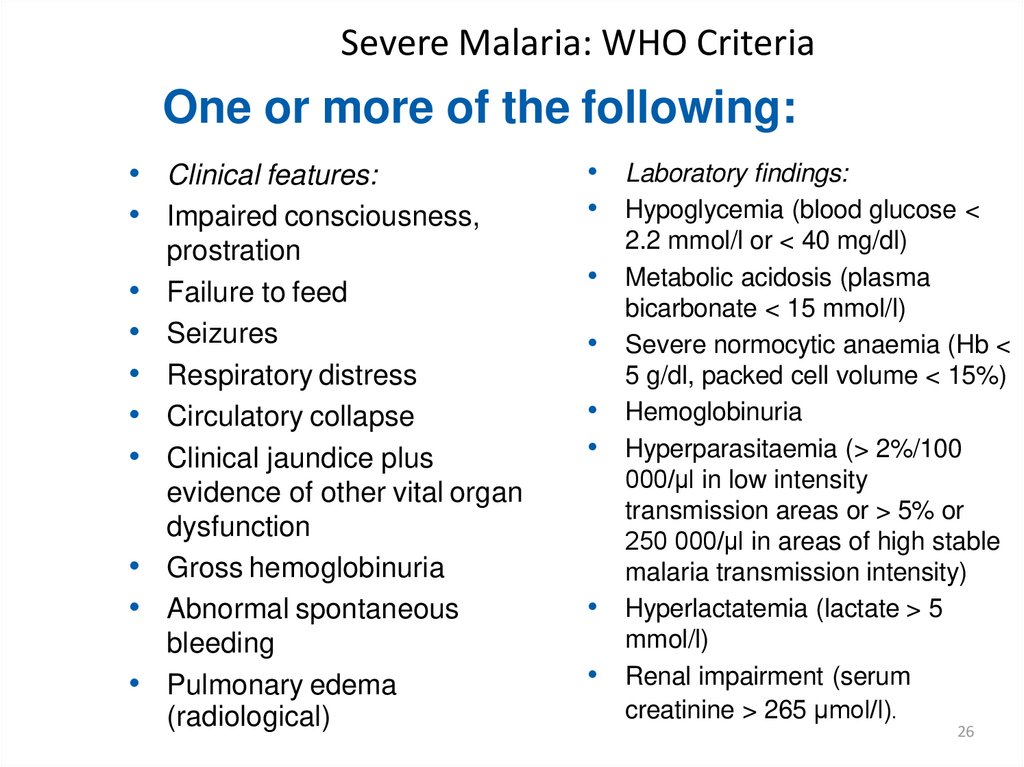
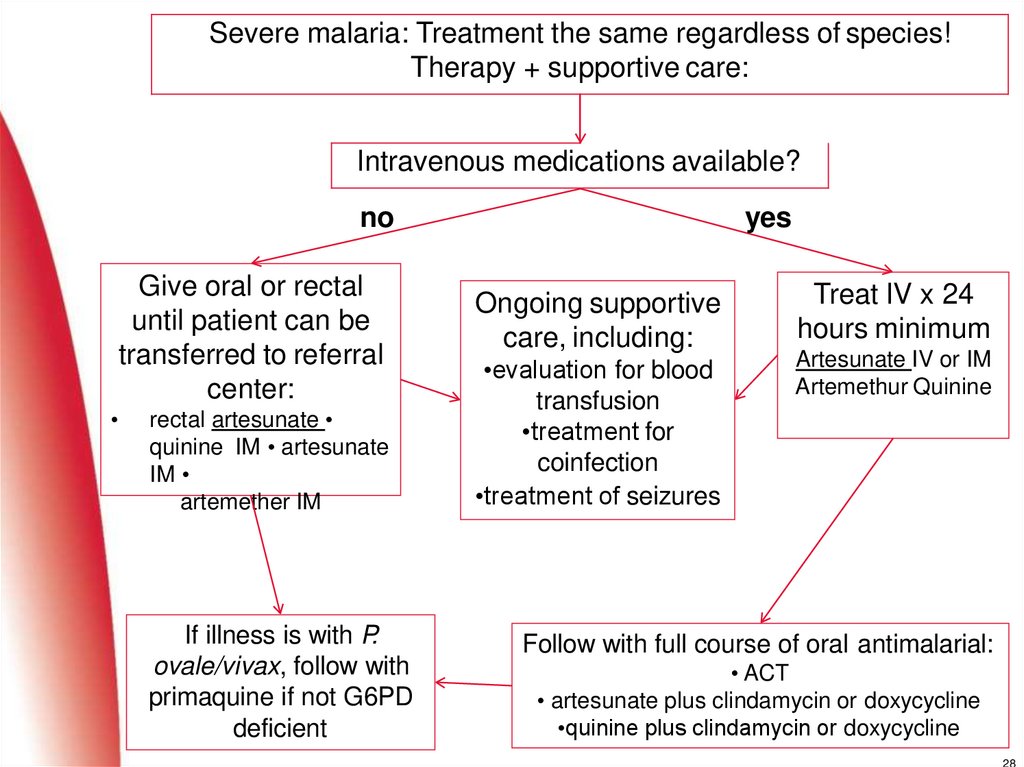
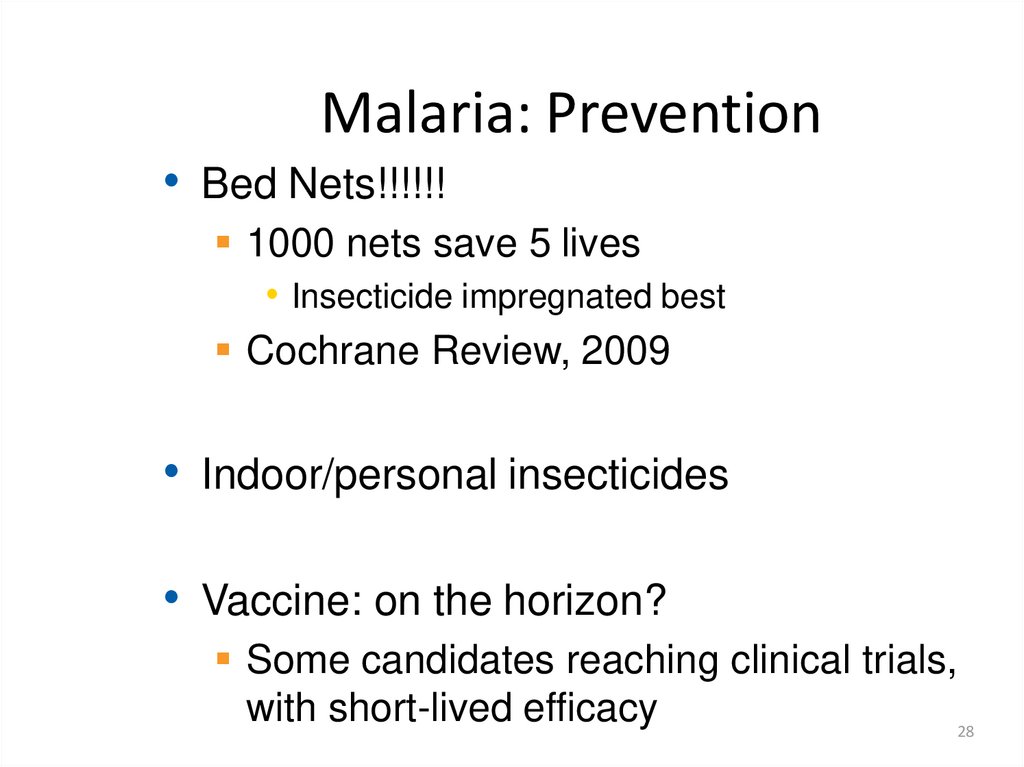

 Медицина
Медицина








